
Hello, Habr! I love to read and collect data. 2020 consisted of 8784 hours, 4874 of which I could take into account in the statistics I collected. I know how I spent 55% of the whole last year! In this article I will try to prove that it is not at all difficult to study at the university, and I will also tell you about my method of time tracking, and at the same time mentally analyze the data collected over the year on the time spent on almost everything I do. From the very beginning of my studies at the university, at the start of each semester, I watched sighing students: "Oh, the ranks have begun! And now a terrible theorver! Diffures are choking. How difficult it is to close the TAU or random processes." And each time we passed the exams, and each time we exhaled with relief, because we spent so much time, we solved such a difficult problem ... And how difficult? What time is it? The further you gothe more often I asked these questions, because subjective opinions are so subjective. We study at a technical university, where are the numbers? Since I began to study well, I was more and more puzzled by the judgments of other students about me, they say, I was just lucky with brains. And to my question how long they bothered this week, I often heard: "Well, I don't know, about two hours." Recently, I was able to quite clearly answer this question to myself, and collected evidence in favor of the obvious thesis: in matters of study, it is not at all a matter of luck with the volume of gray matter in my head, but the amount of time spent.And to my question how long they bothered this week, I often heard: "Well, I don't know, about two hours." Recently, I was able to quite clearly answer this question to myself, and collected evidence in favor of the obvious thesis: in matters of study, it is not at all a matter of luck with the volume of gray matter in my head, but the amount of time spent.And to my question how long they bothered this week, I often heard: "Well, I don't know, about two hours." Recently, I was able to quite clearly answer this question to myself, and collected evidence in favor of the obvious thesis: in matters of study, it is not at all a matter of luck with the volume of gray matter in my head, but the amount of time spent.
clockify.me ? Data Science, , , , , , . ? ( , , )
, , , . , , , , 60 . , .
-, . , . .
/
import math
import pandas as pd
import numpy as np
import matplotlib.pyplot as plt
import seaborn as sns
%matplotlib inline
import matplotlib.dates as dates
import matplotlib.dates as mdates
file_name = "CLK 31 12 20.xlsx"
sheet = "Sheet 1"
df = pd.read_excel(io=file_name, sheet_name=sheet)
print(df)
print(df.info())
[2823 rows x 4 columns]
<class 'pandas.core.frame.DataFrame'>
RangeIndex: 2823 entries, 0 to 2822
Data columns (total 4 columns):
# Column Non-Null Count Dtype
--- ------ -------------- -----
0 Project 2823 non-null object
1 Description 2823 non-null object
2 Start Date 2823 non-null datetime64[ns]
3 Duration (decimal) 2823 non-null float64
dtypes: datetime64[ns](1), float64(1), object(2)
. . . . , , , .
, , . . , - , . - … , ? , , . , -, , -, , . , Nan', .
, . , . , . , .
def remove_duplicates(df):
date = df["Start Date"].to_numpy()
time = df["Duration (decimal)"].to_numpy()
length = len(date)
remove_list = []
for i in range(length - 1):
for j in range(i + 1, length):
if date[i] == date[j]:
time[i] += time[j]
if not j in remove_list:
remove_list.append(j)
df = df.drop(df.index[remove_list])
date = np.delete(date, remove_list)
time = np.delete(time, remove_list)
return df
. 800 .
data = pd.DataFrame()
for project in projects:
descriptions = df[df.Project == project].Description.unique()
for description in descriptions:
df_temp = df[df.Project == project]
df_temp = df_temp[df_temp.Description == description]
new = remove_duplicates(df_temp)
data = data.append(new, ignore_index=True)
print(data.info())
df = data
<class 'pandas.core.frame.DataFrame'>
RangeIndex: 2095 entries, 0 to 2094
Data columns (total 4 columns):
# Column Non-Null Count Dtype
--- ------ -------------- -----
0 Project 2095 non-null object
1 Description 2095 non-null object
2 Start Date 2095 non-null datetime64[ns]
3 Duration (decimal) 2095 non-null float64
dtypes: datetime64[ns](1), float64(1), object(2)
, , . , , , data science . , : b7, b8, m1, m2, m3, games, DS english.
. .
def reindex(data_frame, name='data', start_date='1-1-2019', end_date='12-31-20'):
idx = pd.date_range(start_date, end_date)
dates = pd.Index(pd.to_datetime(data_frame['Start Date'].tolist(), format="%Y%m%d"))
column = data_frame['Duration (decimal)'].tolist()
column = [float(i) for i in column]
series = pd.Series(column, dates)
series.index = pd.DatetimeIndex(series.index)
series = series.reindex(idx, fill_value=0)
data = series.to_frame(name=name)
return data
def plot_kde(data_frame, col_name):
fig = plt.figure(figsize=(14, 7))
ax = fig.add_subplot(111)
sns.distplot(data_frame[col_name], hist=True, ax=ax, bins=20)
fig.savefig('kde.png', dpi=300)
# .
def plot_bar(data_frame, img_name):
fig = plt.figure(figsize=(20, 10))
ax = fig.add_subplot(111)
data_frame.plot.bar(ax=ax, legend=False)
ax.xaxis.set_major_locator(dates.MonthLocator())
ax.xaxis.set_major_formatter(dates.DateFormatter('\n\n\n%b\n'))
plt.tight_layout()
ax.tick_params(labelsize=20)
ax.set_xlabel(" 2020", fontsize=25)
ax.set_ylabel("", fontsize=25)
plt.axhline(y=data_frame.data.mean(), color='r', linestyle='-')
x = list(range(0, data_frame.data.shape[0]))
mean = data_frame.data.mean()
std = data_frame.data.std()
ax.fill_between(x,
(mean - std) if (mean - std) > 0 else 0,
mean + std,
color='silver')
plt.tight_layout()
fig.savefig(img_name, dpi=500)
return ax
# , :)
def stat(data_frame, col_name):
print("Sum: ".ljust(10), "%0.2f" % data_frame[col_name].sum())
print("Mean: ".ljust(10), "%0.2f" % data_frame[col_name].mean())
print("Std: ".ljust(10), "%0.2f" % data_frame[col_name].std())
print("Min: ".ljust(10), data_frame[col_name].min())
print("Max: ".ljust(10), data_frame[col_name].max())
print("Zero: ".ljust(10), (data_frame[col_name] == 0).astype(int).sum())
print("Not zero: ".ljust(10), (data_frame[col_name] != 0).astype(int).sum())
! . Nan-, . , . , , , , .
start_date = '1-1-2020'
end_date = '12-31-2020'
sleep_data = df.loc[df['Description'].isin(['Sleep'])]
sleep_data = reindex(sleep_data,
start_date=start_date,
end_date=end_date)
sleep_data['data'] = sleep_data['data'].replace({0:np.nan})
sleep_arr = sleep_data['data'].to_numpy()
for i in range(1, len(sleep_arr - 1)):
if math.isnan(sleep_arr[i]) and not math.isnan(sleep_arr[i - 1]) and not math.isnan(sleep_arr[i + 1]):
sleep_arr[i] = 0
sleep_arr[np.isnan(sleep_arr)] = np.nanmean(sleep_arr)
sleep_data['data'] = sleep_arr
stat(sleep_data, 'data')
plot_bar(sleep_data, 'sleep.png')
plot_kde(sleep_data, 'data')
, 3224 . , 8784 . , . 0 20 . 16 . , , . , - …
, .
Sum: 3224.42
Mean: 8.81
Std: 3.28
Min: 0.0
Max: 20.0
Zero: 16
Not zero: 350
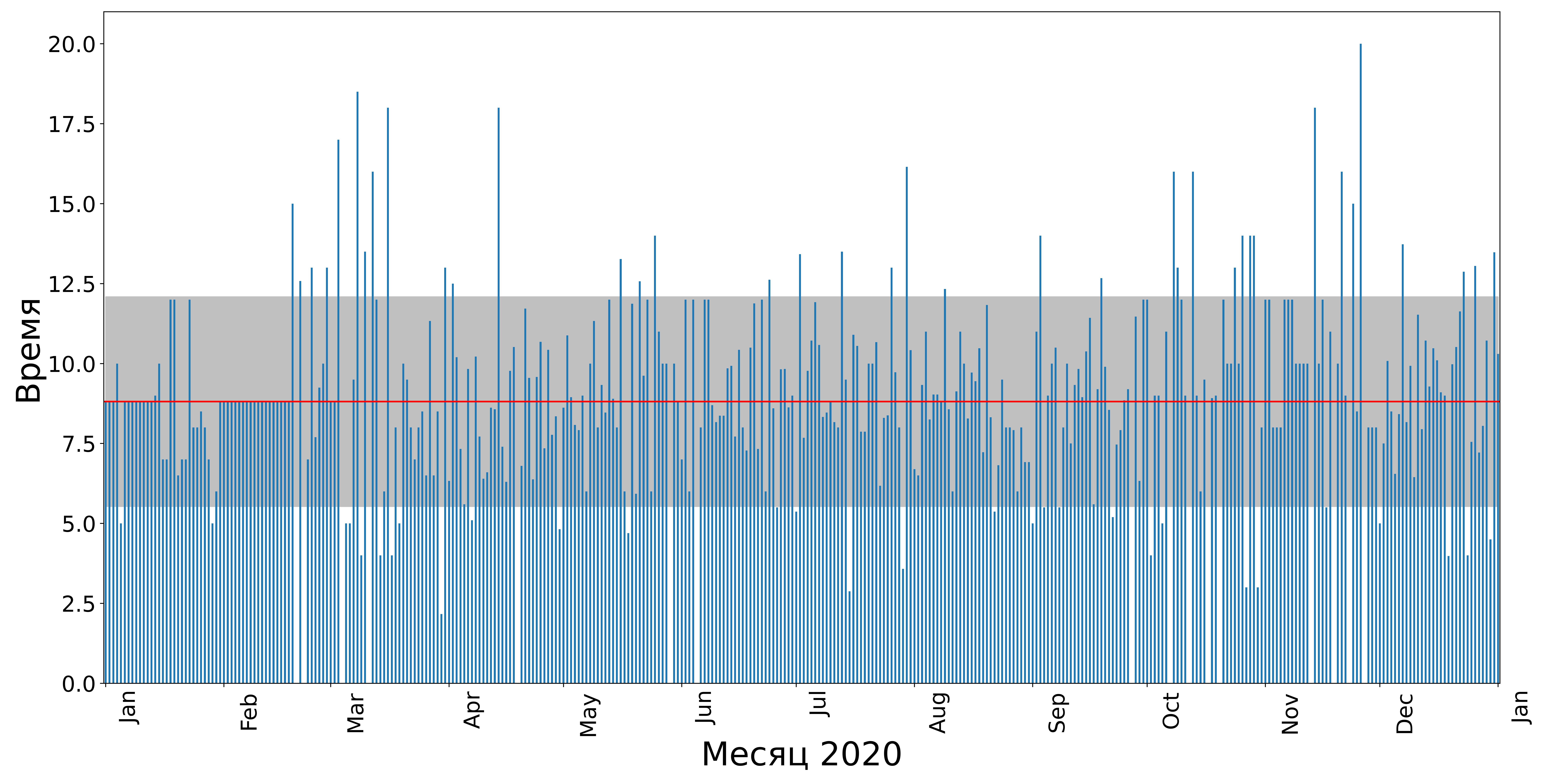
, , . , , !

, . , , .
152 . 216 , DS, , . , , . , , , , , , . , , - . (- ), . , . , .
Sum: 152.50
Mean: 0.42
Std: 0.89
Min: 0.0
Max: 7.73
Zero: 267
Not zero: 99
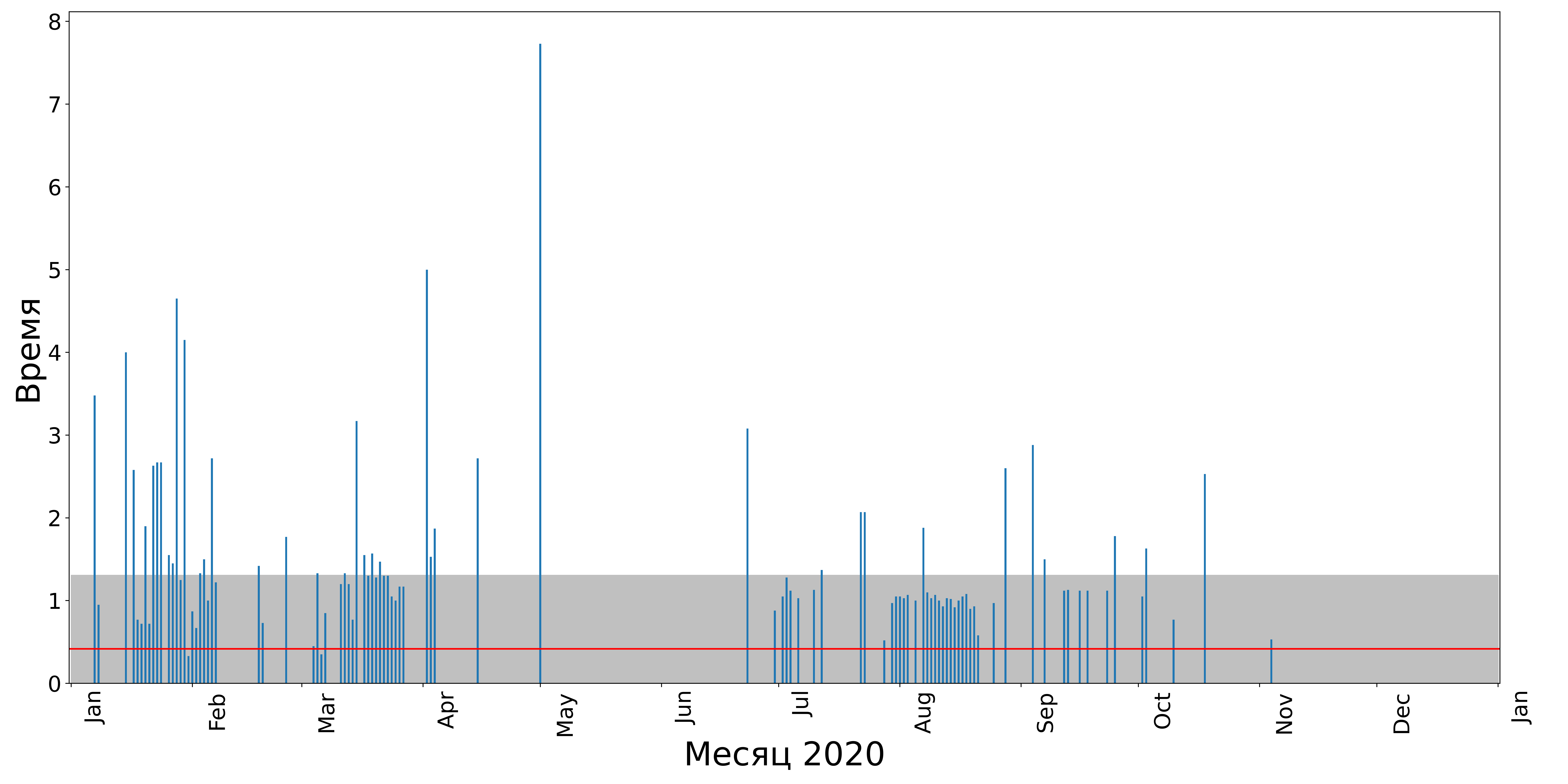
( , ). . , , . , . digital , , 47 . , 100, 160. , … osu, .
Sum: 46.60
Mean: 0.13
Std: 0.58
Min: 0.0
Max: 5.8
Zero: 339
Not zero: 27
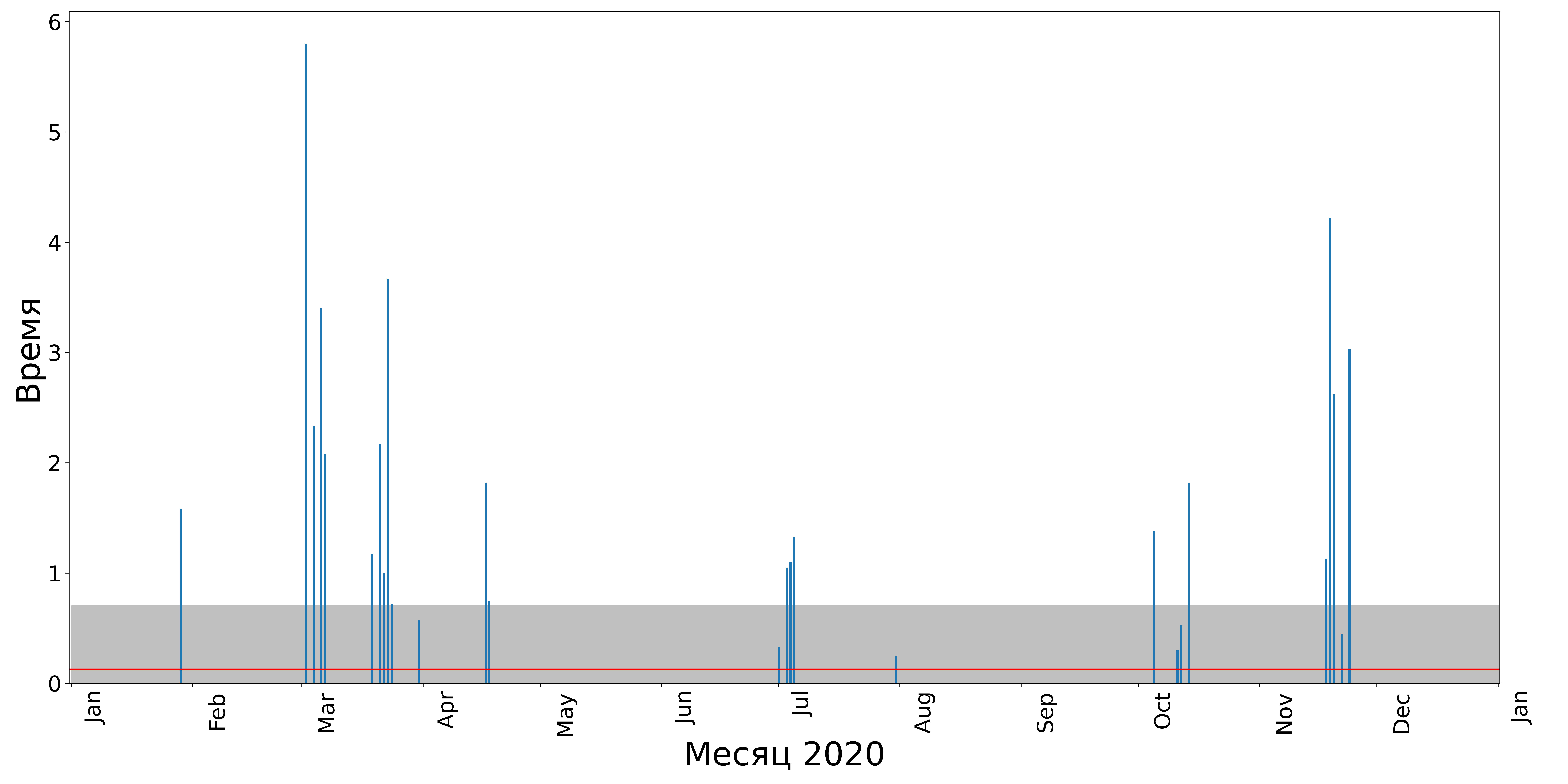
, … , . 90 , , .
Sum: 90.69
Mean: 0.25
Std: 0.58
Min: 0.0
Max: 3.13
Zero: 282
Not zero: 84
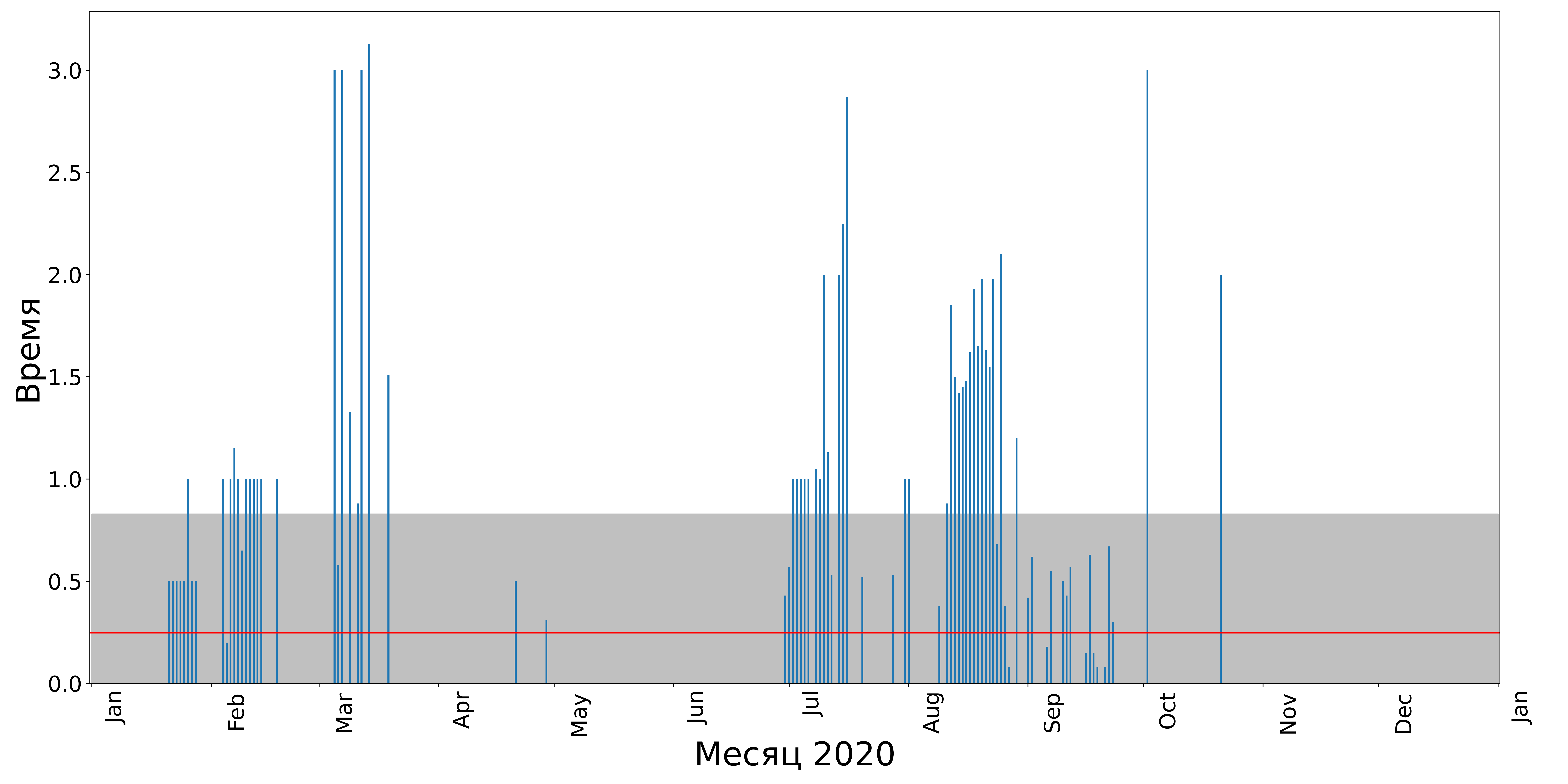
, . , ! , . , . , , ( ). , - 50 , . … … … , , . . . , . , , , … , . , .
Sum: 52.42
Mean: 0.14
Std: 0.45
Min: 0.0
Max: 3.18
Zero: 320
Not zero: 46
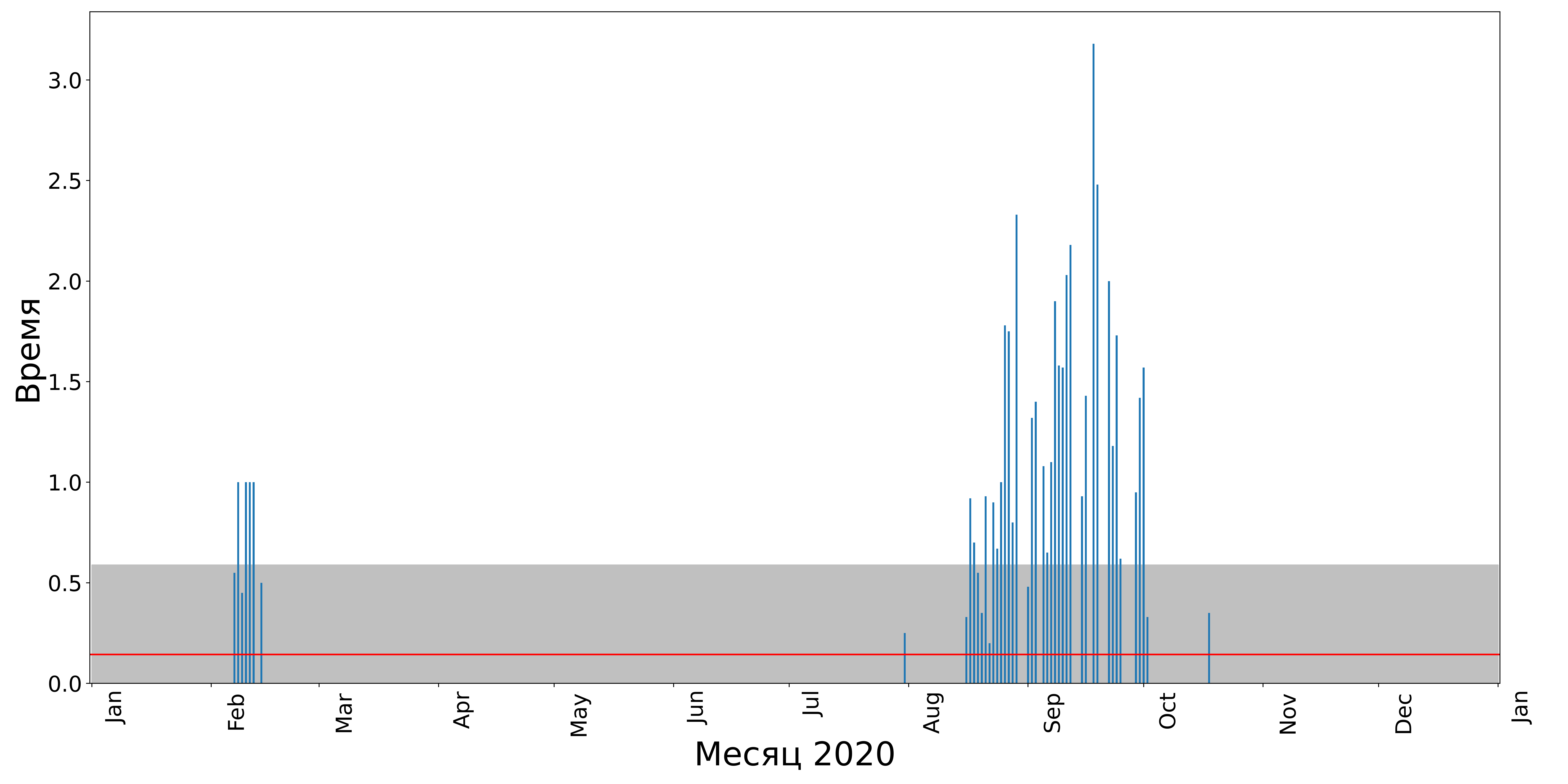
- , .
. . , 344 . su , … , - . , - , , - ? , . , .. , (, , ). , . , . , , .
Sum: 344.03
Mean: 0.94
Std: 1.62
Min: 0.0
Max: 12.0
Zero: 165
Not zero: 201

Data science
data science. , . , - . 208 , . , , - , , . Anrew Ng - . , , , , .
Python (18 ), Andrew Ng (32 ), (19 ).
Sum: 208.30
Mean: 0.57
Std: 1.04
Min: 0.0
Max: 6.0
Zero: 254
Not zero: 112
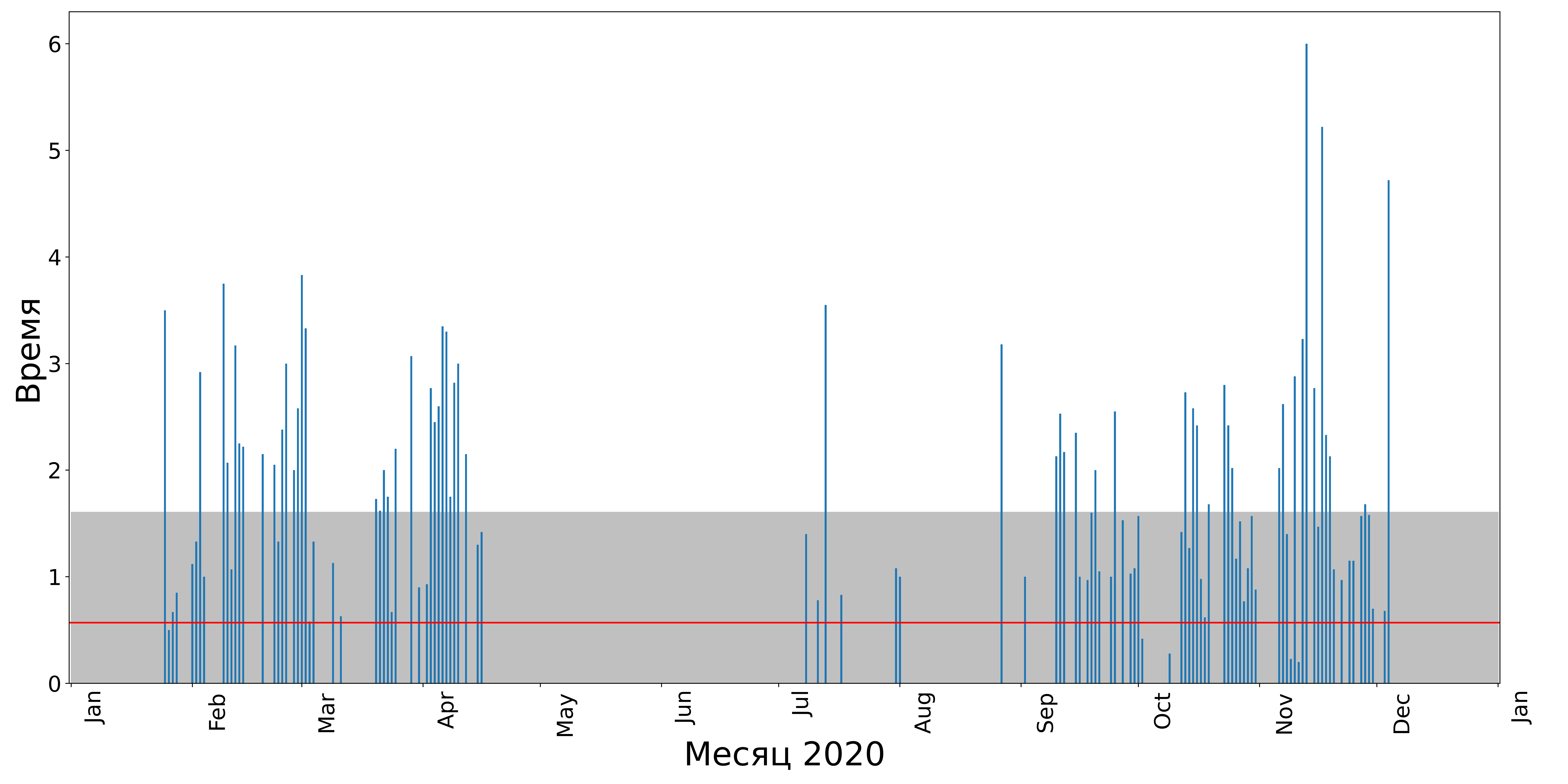
\\
. +10 . , , . , . Breaking Bad. . , , , , .
Sum: 271.24
Mean: 0.74
Std: 1.25
Min: 0.0
Max: 9.5
Zero: 220
Not zero: 146
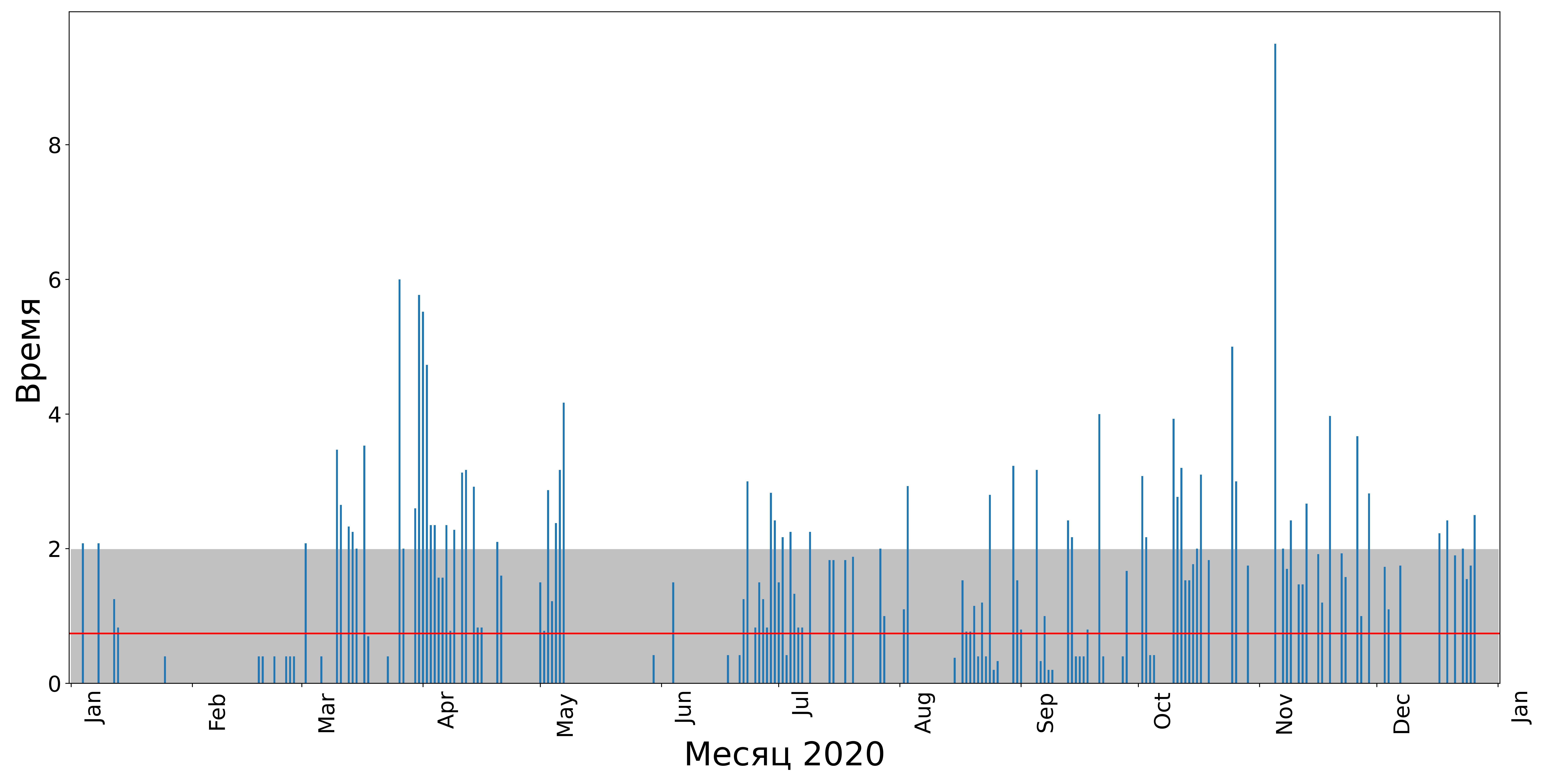
- , . , 95 . , , . ? ! , ! , .
Sum: 192.04
Mean: 0.52
Std: 0.41
Min: 0.0
Max: 1.0
Zero: 128
Not zero: 238

, ?
- . . . .
def plot_bot(data_frame, start_date, end_date, year, img_name):
descriptions = data_frame.Description.unique()
df = pd.DataFrame(reindex(remove_duplicates(data_frame[data_frame.Description == descriptions[0]]),
name=descriptions[0],
start_date=start_date,
end_date=end_date))
for description in descriptions[1:]:
new = reindex(remove_duplicates(data_frame[data_frame['Description'] == description]),
name=description,
start_date=start_date,
end_date=end_date)
df[description] = new[description].to_numpy()
fig = plt.figure(figsize=(20, 10))
ax = fig.add_subplot(111)
df[descriptions].plot(kind='bar', stacked=True, figsize=(30, 15), ax=ax)
ax.xaxis.set_major_locator(dates.MonthLocator())
ax.xaxis.set_major_formatter(dates.DateFormatter('\n\n\n%b\n'))
ax.tick_params(labelsize=20)
ax.set_xlabel(" " + str(year), fontsize=25)
ax.set_ylabel("", fontsize=25)
ax.legend(fontsize=30)
ax.grid(axis='y')
df['Sum'] = df[list(df.columns)].sum(axis=1)
#ax.set_xlim(243, 395) #m1
#ax.set_xlim(45, 181) #m2
#ax.set_xlim(245, 366) #m3
plt.tight_layout()
fig.savefig(img_name, dpi=300)
return ax, df
: , . , , , . , - . . , . , , . 212 = 116 , 1,8 . , . , . , . . " ?" , . , , : " ???" , , . , , , .
. 66 " ". . , , , 400 , 200 . = = … ", , 400 000 / 24 = 16 666 !!!" ! 13700. 66 208 . , 236 , .
Sum: 390.97
Mean: 1.07
Std: 2.10
Min: 0.0
Max: 10.0
Zero: 252
Not zero: 113
: 212
: 66
: 66
: 212
: 15
: 28
: 25
: 16
: 12
: 13

. , , . , 234 ( B&R ). , 96 . , . , , , 1 20 , . , .
Sum: 234.95
Mean: 0.59
Std: 1.40
Min: 0.0
Max: 12.64
Zero: 296
Not zero: 99
: 1.22
: 62
: 172
: 34
: 13
: 56
: 52
: 18
: 15
: 28

. . , . . 165 . . . 152 . . , 12 . , .
Sum: 165.84
Mean: 0.45
Std: 1.21
Min: 0.0
Max: 7.97
Zero: 301
Not zero: 65
: 0.92
: 12
: 153
: 29
: 7
: 48
: 12
: 18
: 40
: 8

. 58 , 120. , . , .
Sum: 58.60
Mean: 0.16
Std: 0.58
Min: 0.0
Max: 4.5
Zero: 327
Not zero: 39
: 15
: 43
: 1
: 6
: 0
: 5
: 24
: 4

. , -, . , .
: 787
: 650
: 492

2020 .
Time, h Time, % Time per day
Nan 3910 44.5 10.7
Sleep 3224 36.7 8.8
Games 344 3.9 0.9
Study 295 3.4 0.8
Watching films 271 3.1 0.7
DS 208 2.4 0.6
Walks 192 2.2 0.5
Reading books 152 1.7 0.4
English 90 1.0 0.2
Japanese 52 0.6 0.1
Drawing 46 0.5 0.1
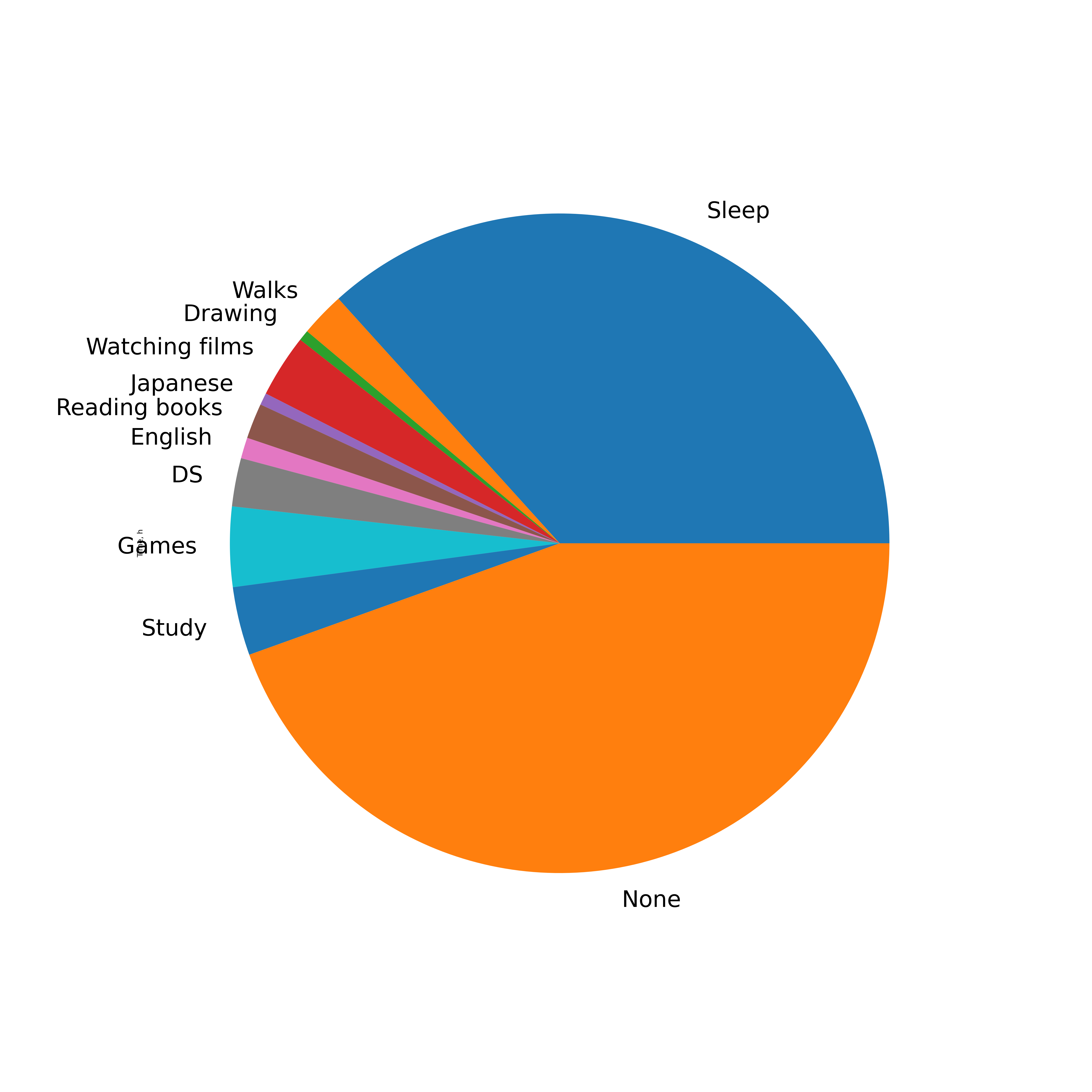
, . , . , , . , , .
, . 235 , 96 . , ! 1 13 , 2 . ? . , - . , , - . 165 152 . 55 , 1 22 . .
, . , , . , , , - , . , ( ), , ( ), . , , , . , !
P.S.
, . , , "". . , . ... , .
? : . , .
? . - , Data Science. , - , : ", ". , , . , 1089 , LSTM. , 400 - . . , 2020- , . , . , ?! , , , .. , .
, . , . . Python 420 , , - 18 . , . , - . , )
P.P.S.
. , , . , . !